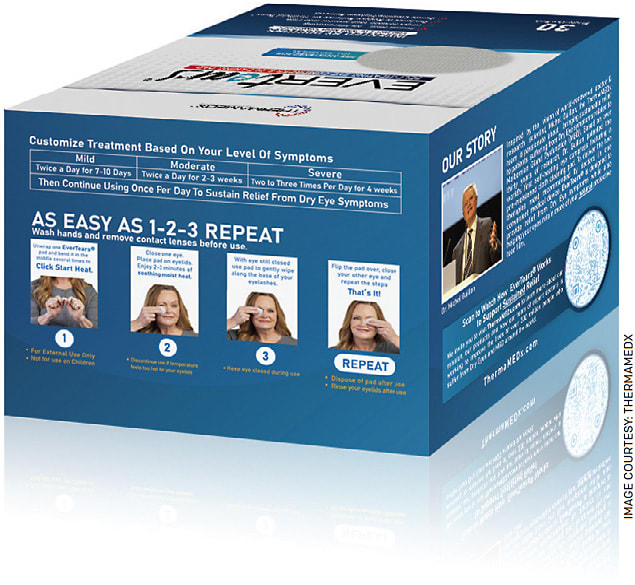The EverTears pre-moistened self-heating pad can help patients adhere to a treatment routine.
Having just settled into bed after a long day, your patient suddenly remembers that she hasn’t done her hot soaks and scrubs to treat her dry eye. At this moment, and despite her best intentions, is she really going to get out of bed, head to the microwave and prepare her treatment?
Perhaps not, says Marguerite McDonald, MD, FACS, clinical professor of ophthalmology at both NYU Langone Medical Center, New York, N.Y. and Tulane University Health Sciences Center, New Orleans and cataract/refractive/cornea surgeon at OCLI Vision in Long Island, N.Y. “People are in a hurry in the morning to get to work, and they’re exhausted at night. The compliance is dreadful with hot soaks and scrubs.”
To help address such inconvenience, ThermaMEDx launched EverTears, a pre-moistened, self-heating disposable, cleaning eye-pad to treat dry eye and meibomian gland dysfunction (MGD). The nonprescription pad combines moist heat with cleaning. “It’s a combination heating device and lid scrub,” says William B. Trattler, MD, Center for Excellence in Eye Care, Miami. EverTears is available through eye-care providers or the company’s website, www.thermamedx.com .

BEND TO HEAT
To use EverTears, a patient unwraps the pad from its sealed pack and bends it back and forth in the middle to heat the pad. The patient applies the pad to one eye for 2-3 minutes then gently wipes along the base of the eyelashes. The patient flips the pad and repeats the process on the other eye.
The EverTears pad warms to approximately 40°C, Dr. McDonald explains. This temperature, she notes, provides liquification of the lipid layer, thinning the thick meibum produced by almost all dry eye patients. There’s a rapid effect on the tear lipid layer thickness, she notes. “The rationale is the heat liquefies the meibum and improves the film lipid layer,” says Dr. McDonald. The pad maintains the heat for roughly 7 minutes, she notes, giving the patient ample time to perform the treatment on both eyes.
In addition, the product avoids potential scalding of the eyelid that could occur when patients overheat a compress. “You can really do yourself some serious damage,” says Dr. McDonald. “This takes all of that guesswork away.”
After loosening the meibum, the patient uses the pad to remove the melted meibum and debris. The technology provides skin rehydration and meibum cleaning under controlled, sustained heat, according to ThermaMEDx. The goal of this cleaning, notes Dr. Trattler, is to remove the crust, which often is considered biofilm, and reduce the bacterial load.
MASSIVE NEED
The need for a convenient dry eye treatment is significant. One of the most common reasons that patients visit an eye-care practitioner, according to Dr. McDonald, is ocular surface disease, including dry eye and blepharitis. She cites “classic” studies by Lemp et al and Nichols that found dry eye disease (DED) is accompanied by MGD in 86% to 92% of cases.
Untreated ocular surface disease represents a significant challenge post-surgically as about 80% of patients evaluated for cataract surgery have preexisting dry eye, says Ben Nobles, citing the Prospective Health Assessment of Cataract Patients Ocular Surface Study. A founding partner at ThermaMEDx, he adds that it is also the primary reason for contact lens drop out.
“Our mission,” says founding partner Carl Sweat, “is to enhance the outcomes for patients with ocular surface disease, principally dry eye but not limited to that.”
‘PERFECT MARRIAGE’
EverTears and other dry eye treatments such as drops and intense pulsed light represent a “perfect marriage,” says Dr. McDonald. “We love to do the in-office procedures, which are highly effective, and have [patients] use EverTears at home for maintenance between treatments.”
Even if DED isn’t a practitioner’s focus, EverTears can provide a clinically important tool. For instance, it’s common, notes Dr. McDonald, for her cataract patients to have clinically significant ocular surface disease, such as dry eye or blepharitis. If she notes that a cataract surgery patient has a tear osmolarity score of 317 mOsm/L or higher, she starts the patient on prescription immunomodulators to clear up the dry eye prior to surgery. If the patient scores at level two on the blepharitis/MGD scale (from 2011 The International Workshop on Meibomian Gland Dysfunction: Executive Summary), she will instruct the patient to use EverTears twice a day to clean up the eyelids.
ThermaMEDx recommends that patients with mild dry eye utilize the single-use EverTears pads twice a day for 7-10 days; patients with moderate dry eye, twice a day for 2-3 weeks; and patients with severe dry eye, two to three times per day for 4 weeks. After that, patients should continue to use EverTears once a day.
IMPROVED COMPLIANCE
In one early user site study of the product, seven patients used EverTears for 3 weeks. All those patients, according to Mr. Nobles, improved at least one grade level on the Ocular Surface Disease Index scale and showed objective clinical improvement with improved tear breakup time.
“I’ve noticed in my own practice that compliance has gone up when patients use this product,” says Dr. McDonald. “When patients come back, they say ‘This is so much easier and faster for me.’”
“It’s a nice, easy device to use because it’s simple,” explains Dr. Trattler. “It’s easy, it’s cost effective, and it’s a nice addition to our armamentarium.” OM
Dr. McDonald and Dr. Trattler are consultants to ThermaMEDx.








